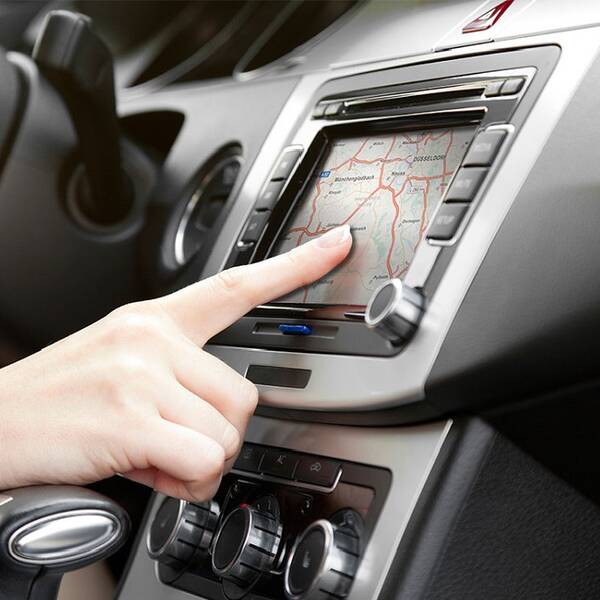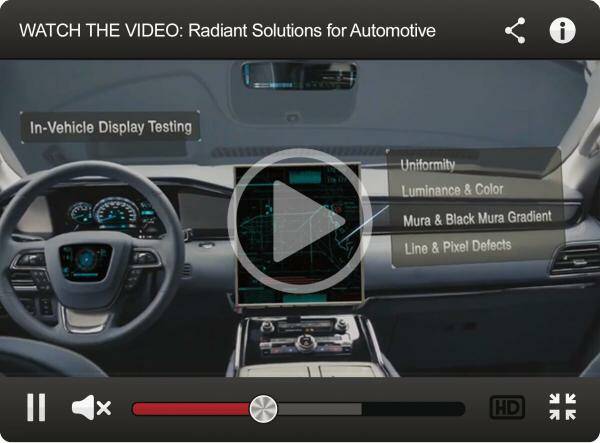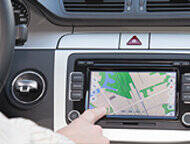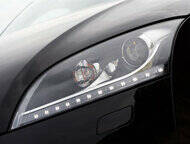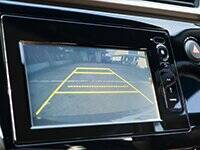In today’s automobiles, versatile high-resolution touchpads have replaced analog gauges and knobs. Modern smart lighting adjusts to changing conditions. Radios have been replaced with multi-function, touch-sensitive infotainment displays. Generic sealed-beam and capsule headlamps have been superseded by stylish, aerodynamically-efficient, model-specific LED and HID headlamp assemblies. Head-up displays (HUDs) are becoming an automotive standard.
Radiant Vision Systems offers a complete portfolio of measurement solutions to increase design efficiency and control production costs of automotive displays, lighting systems, and illuminated symbols. Radiant's fully integrated measurement systems are helping automakers and suppliers worldwide improve their R&D, quality control, and production operations.
In-Vehicle Displays
Embedded LCD and OLED Displays
Instrumentation, information, navigation, and entertainment systems are all moving to display technology. Expectations for color and clarity of these displays are high, based on consumer experience with TVs, computers, and phones. A perfect display is critical to the purchase decision and long-term customer satisfaction. Human inspection cannot accurately and efficiently detect display faults. Automated display inspection for luminance, chromaticity, uniformity, line/pixel defects, and mura can prevent “escapes” and ensure a perfect end-user experience. Radiant’s integrated inspection solutions, using a ProMetric® Imaging Colorimeter or Photometer and TrueTest™ Automated Visual Inspection Software, can perform automotive-specific inspection applications, including testing per the German Automotive Black Mura Standard.
Related Links:
Illuminated Symbols
Instrument Clusters, Controls, Tell-Tales & Indicators
A ProMetric system comprised of an imaging colorimeter and ProMetric Software is a simple and accurate solution for testing illuminated characters. The software features a powerful tool (Auto-POI, or Automatic Points-of-Interest) that allows users to automatically select points of interest based on location or color and luminance values (Lv and CIE x,y thresholds).
You can then run calculations on a single character, or a group of like-characters, to ensure uniformity within or between symbols regardless of location, shape, size, or color. The Auto-POI system provides comprehensive data through ProMetric Software, including average luminance across characters, points of minimum and maximum luminance, color value, and dominant wavelength.
Related Links:
Headlamps
Headlamp Evaluation & Analysis
A Radiant system can be indispensable in headlamp evaluation applications, particularly as they grow in complexity. Today's smart headlamps require multiple measurements to ensure proper illumination at all settings. An effective and efficient method for evaluating headlamp performance is to project the light source onto a prepared flat surface (a wall or a diffuser), where the imaging colorimeter captures the illumination distribution in a single measurement. A manufacturer can then analyze the assembly on a number of user-defined criteria using Radiant’s PM-HL™ Headlamp Evaluation Module, designed specifically for headlamp evaluation.
PM-HL functions include:
- Light source illuminance distribution measurement
- Evaluation of ECE and SAE Regulation test points
- Evaluation of custom test points
- Evaluation of beam pattern cut-off gradients
- Conversion to luminous intensity distribution
- Conversion to roadway illumination distribution
- Data analysis functions, including bitmaps, isoplots, and cross-sections
LED Lighting
Direct measurement of LED headlamps, taillights, and accessory light strips can be readily addressed with a ProMetric Imaging Colorimeter and ProMetric or TrueTest Software. Within a single image captured by a ProMetric system, manufacturers can measure uniformity of luminance and color along a cross-section or path (accommodating all shapes), detect failed LEDs in a cluster or array, and determine luminous intensity distribution of LEDs and backlit components (only available in TrueTest). Radiant software registers all individual LEDs in an array from a single image, and uses dynamic ROI to determine individual LED locations to report the performance of each including luminance, chromaticity, and other visual qualities.
Related Links:
Head-Up Displays (HUDs)
HUD Measurement
Head-up displays (HUDs) pose unique measurement challenges for manufacturers, who must take into account potential luminance changes on an infinite plane. ProMetric imaging colorimeters and photometers feature an electronically-controlled lens that is highly effective at identifying and focusing on an image projected into infinity. This capability enables ProMetric analysis software to provide accurate luminance and chromaticity measurements at any working distance.
The TT-HUD(TM) module of our TrueTest(TM) Software provides specific tests used to evaluate the quality of augmented projections, such as those emitted by head-up display (HUD) systems.
Related Links:
Camera Monitor Systems (CMS)
Optical Performance Measurement
Adopted by several countries, UN Regulation No.46 is the first to permit the legally-required mirrors in passenger and commercial vehicles to be replaced by electronic display-based systems known as camera monitor systems (CMS). In the US, the National Highway Traffic Safety Administration (NHTSA) is considering approval of CMS as a rear visibility system governed by Federal Motor Vehicle Safety Standard (FMVSS) No. 111.
To align CMS design and implementation with both UN and US requirements, testing methods are documented in UN Regulation No. 46, ISO 16505 ("Road vehicles — Ergonomic and performance aspects of Camera Monitor Systems — Requirements and test procedures"), and the SAE J3155 Recommended Practice (“Camera Monitor Systems Test Protocols and Performance Requirements”). SAE J3155 draws from ISO 16505 documentation and provides recommended test parameters to support FMVSS No. 111 in the US. All documents outline methods for testing CMS optical, electrical, mechanical, and functional effectiveness. Required tests performed at the display are intended to evaluate the integrity of the CMS camera’s signal as well as the visual performance of the display itself for ideal mapping of the real-world scene.
Radiant ProMetric Imaging Colorimeters and Photometers paired with TrueTest Software provide a solution for CMS display testing that includes advantages for testing efficiency (performing all measurements through a single solution), CIE-matched color evaluation, high-resolution imaging for testing MTF of test images at required 10-meter distances, MTF testing compliant with required ISO 12233 parameters for Slant Edge Contrast evaluation, angular performance measurement for various viewing directions (using the Radiant FPD Conoscope Lens), and a software test suite.
Related Links:
Small Light Sources
Light Source Characterization
Small light sources, such as bulbs or LEDs, may be characterized by a near-field model for use in optical design applications. To create this model, a precision goniometric system (SIG-400 Source Imaging Goniometer®) with a ProMetric Imaging Colorimeter takes measurements of luminance and color of the light source from multiple viewing angles. The measurement output is a Radiant Source Model™ (RSM) file that describes the near-field luminance distribution around the source. This RSM is supported by all major optical/illumination design software packages, and is converted to a ray set using Radiant ProSource® Software. These ray sets support optical design, and allow you to extrapolate a near-field model into a far-field model.


